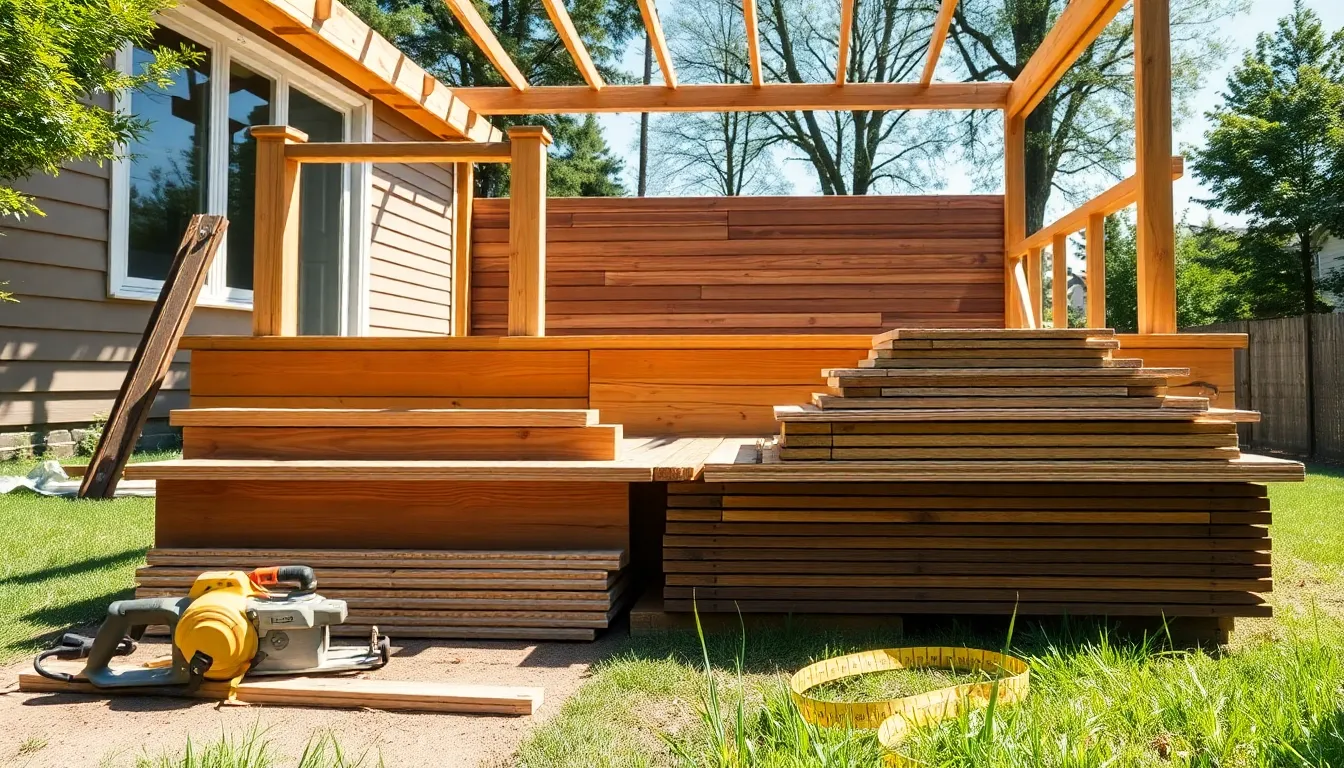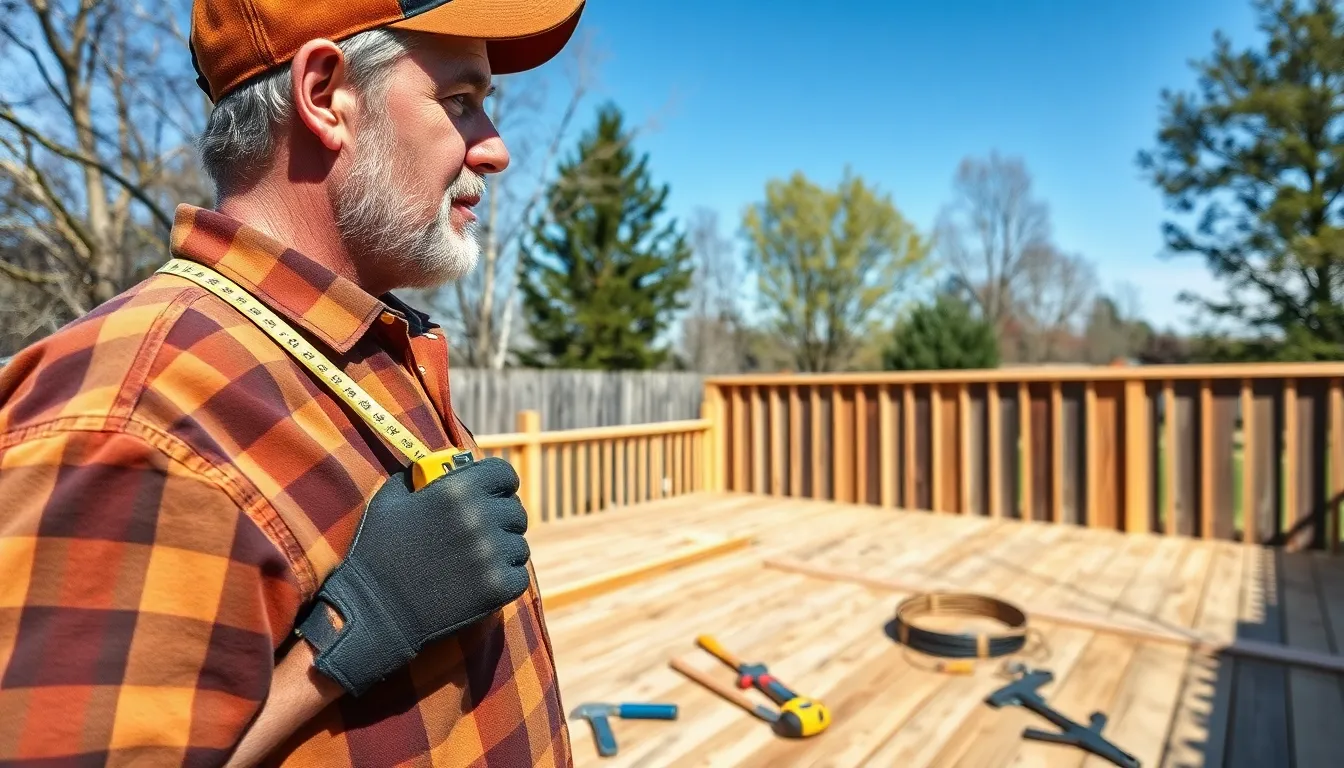Building a deck can feel like a dream come true—until the reality of deck costs hits. Suddenly, that picturesque outdoor oasis transforms into a math problem that even the best calculators struggle with. But don’t worry, they’re not all doom and gloom! Understanding the factors that influence deck costs can help anyone make informed decisions without breaking the bank or losing their sanity.
Table of Contents
ToggleOverview of Deck Cost
Deck costs vary significantly based on several factors. Materials play a crucial role in overall expenses. Common options include wood, composite, and PVC, each with distinct price ranges and durability.
Labor costs also impact the budget. Professional installation typically averages $25 to $60 per hour, depending on the contractor’s experience and location. A DIY approach can save money, although it may require time and effort for those unacquainted with construction.
Deck size directly affects costs. Larger decks demand more materials and labor, increasing expenses. According to industry standards, a standard 10×10-foot wooden deck can cost between $1,500 and $2,500, while larger projects can exceed $20,000.
Design complexity influences costs as well. Additional features, such as railings, stairs, and built-in seating, contribute to the final price. Custom designs increase expenses due to unique requirements and specialized labor.
Seasonality should be considered. Building during peak seasons can lead to higher costs due to demand. Homeowners can sometimes find better pricing during off-peak times or winter months.
Permitting and inspection costs are often overlooked. Many regions require permits for deck construction, adding fees that range from $100 to several hundred dollars. It’s essential to check local regulations before starting the project.
Budgeting for maintenance is vital for long-term investment. Annual upkeep costs, like staining or sealing, can affect the overall financial commitment once the deck is built. Understanding these factors helps create a comprehensive budget.
Factors Influencing Deck Cost

Understanding the factors influencing deck cost helps individuals create a budget for their project. Various elements determine the final price, including material selection and deck size and design.
Material Selection
Different materials significantly impact deck costs. Wood, including pressure-treated lumber, generally offers lower initial pricing, ranging from $2 to $5 per square foot. Composite materials can cost between $5 and $12 per square foot, providing greater durability and lower maintenance. PVC decking often sits at the higher end, costing around $10 to $15 per square foot due to its longevity. Homeowners should assess the trade-offs between upfront costs and long-term maintenance to make informed choices.
Deck Size and Design
The size and complexity of the deck drive up costs. A standard 10×10-foot wooden deck might start at $1,500, while larger decks easily exceed $20,000. Unique designs, such as multi-level structures or integrated features like benches and planters, further increase expenses. Customization adds to both material and labor costs, with complex designs requiring more time for installation. Prioritizing size and design elements ensures alignment with budgetary constraints.
Cost Comparison of Different Materials
Understanding the cost implications of various decking materials helps homeowners choose wisely. Here’s a comprehensive look at the expenses involved with the three main decking options: wood, composite, and PVC.
Wood Decking
Wood decking remains a popular choice due to its natural aesthetic. Initial costs range from $2 to $5 per square foot, making it budget-friendly. Pine and cedar are common options, each offering distinct appearances and durability. While upfront investment is lower, maintenance costs can accumulate over time. Decks made of wood typically require annual sealing and staining to preserve their integrity. Longevity varies, with well-maintained wood decks lasting roughly 10 to 15 years. Homeowners should factor in these maintenance responsibilities when budgeting for wood decking.
Composite Decking
Composite decking stands as a blend of wood fibers and recycled plastic, presenting an eco-friendly alternative. Pricing falls between $5 and $12 per square foot, reflecting the enhanced durability and lower maintenance needs. Unlike wood, composites resist fading, splintering, and warping. These materials typically last 25 to 30 years, significantly reducing long-term costs associated with replacements. Although the initial expenditure is higher, the sturdiness and minimal upkeep make composite decking appealing. Homeowners should evaluate the trade-offs between upfront costs and hassle-free maintenance.
PVC Decking
PVC decking offers a synthetic solution characterized by its durability and weather resistance. Costs range from $10 to $15 per square foot, positioning it as the premium option among decking materials. This decking type does not require staining or sealing, significantly lowering ongoing expenses. Lifespans can extend beyond 30 years, often outlasting wood and composite materials. With a wide range of colors and textures available, PVC accommodates diverse design preferences. Homeowners must weigh the higher initial costs against the benefits of minimal maintenance and increased longevity.
Additional Costs to Consider
Building a deck involves various additional costs beyond the initial materials and labor. Awareness of these expenses ensures a well-balanced budget.
Installation Fees
Installation fees vary based on the deck’s complexity and size. Hiring professionals typically incurs costs between $25 and $60 per hour. The total installation price can increase significantly depending on design intricacies. For example, a more elaborate layout may require specialized skills, leading to higher labor charges. Additionally, geographic location impacts installation fees, as demand in urban areas often raises rates. Homeowners should clarify quotes and understand what’s included to avoid surprises.
Maintenance Expenses
Maintenance expenses affect long-term deck ownership. Wooden decks generally require more upkeep, including staining and sealing, which can accumulate costs over time. For example, homeowners may spend $300 to $500 annually on maintenance. In contrast, composite and PVC materials have lower maintenance needs. Composite decks, needing occasional cleaning, may incur costs around $50 to $100 yearly. PVC decking, with its durability and minimal upkeep, often costs even less. Understanding these expenses ensures better planning for ongoing financial commitments.
Building a deck is an exciting venture that can enhance outdoor living spaces. However understanding the costs involved is crucial for making informed decisions. By considering factors like material selection size and design homeowners can create a budget that aligns with their financial goals.
The choice between wood composite and PVC materials affects both initial costs and long-term maintenance. Additionally keeping an eye on installation fees and potential extra costs ensures a smooth project experience. With careful planning and research homeowners can turn their deck dreams into reality without breaking the bank.



